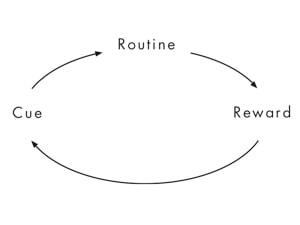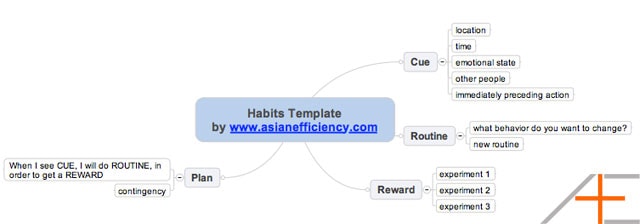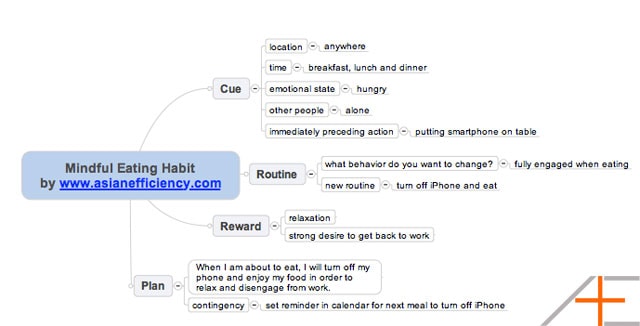
Recently I had the opportunity to read a fantastic book on habits and how they really work backed with some scientific research. What really stood out how the author was able to break down habits into different components that would make it much easier to adapt new habits and change old ones. With help of mind maps building new habits has become even easier. Here’s how.
Quick Summary
- Each habit consists of a cue, routine and a reward.
- Mind maps support you in planning your habit and effectively overseeing it.
- Each mind map will have a branch for each habit component.
- Specify your plan of action and details in your mind map.
Habits 101: The Habit Loop
In the book The Power of Habit, author Charles Duhigg writes how each habit can be broken down into different parts and I’m going to borrow his framework for this post. In short, each habit consists of three components:
- Cue
- Routine
- Reward
This is the habit loop. A habit starts with a cue, a routine or action takes place and at the end is a reward. This process gets repeated over and over again.

Each habit is started by a cue or another way of phrasing that is that a trigger is what will initiate a habit. This could be a smell, an emotional state, a visual cue or anything else that could start a habit. The cue can be broken down further in five parts:
- Location
- Time
- Emotional state
- Other people
- Immediately preceding action
The routine is the actual habit – what you do after you receive the cue. Typically this is the behavior that you want to change.
We have habits to save effort and predictably satisfy our cravings, and that’s why every habit has a reward attached. Whether you are consciously aware of it or not, we have habits to drive us to take action that leads to a (repeatable) outcome that we want. However, as the author found out, to effectively change a habit you need to experiment with different rewards.
The book is great because it explains how habits work with a lot of scientific research and the author has broken it down in several components. This of course is a blessing for anyone who is geeky (and a system thinker) like myself because once you know the different moving parts you can streamline everything.
After reading the book I identified right away how you can use mind maps to build new habits. With help of mind maps you can plan ahead how you are going to adapt and incorporate any new habit with the knowledge of the aforementioned habit loop and its components.
Mindmapping Your Habit
The reason mind maps are great for building your habits is because you can visualize the different habit components in a mind map and visually see how you are going to work on each part. You can really think it through and be specific on what needs to happen. Like Tony Schwartz says in The Power of Full Engagement (review), the key to building rituals (his catchphrase for habits) is being absolutely specific on what needs to happen, when, where and having a contingency plan when you aren’t executing the desired habit. Can you already see how this would be really useful in a mind map?
BTW: If you are new to the concept of mind mapping, we have a whole page dedicated about it with more articles and posts.
To get an idea what this looks like, here’s a template you can use for building habits.

Each component has its own branch and you can populate it with specific details. I’ve added an extra branch called “Plan” to map out the new routine but also to add anything extra such as notes, details and more importantly a contingency plan.
Once you have mapped out all the branches and details, then you can start working on your habits effectively and efficiently – just the way we like it here at Asian Efficiency.
Example of Mindful Eating
To show you how this works, I’ll show you how I’ve been recently working on incorporating the habit of mindful eating in my life. It’s the practice of being fully engaged when I am eating food and not multitask at the same time. In the past I would try to watch a TED talk while I’m eating or I would be reading an article of my Instapaper stack – this didn’t allow me to fully disengage and relax. I was always on the edge of being too engaged with my activities that whenever I did want to relax I would take up too much time doing that in big blocks of time (instead of intermittently throughout the day).
Here’s the mind map I’ve created for my mindful eating habit.

Cue
The main cue was putting my iPhone on the table and within reach. As soon as that happened, I would immediately fire up Instapaper or watch a video. I’ve also added the location, time, emotional state, other people and immediately proceeding action as a way to break it down even further. Notice how this only happens when I’m alone. When I’m eating with people, I never do this because I’m fully engaged with the people around me. However, when I’m alone I “multitask” all the time. Part of it I think is because when I’m by myself I always try to squeeze out the most of my days and then unwind with friends and specific time off.
Routine
The routine that needs to be replaced is keeping myself distracted from food. This is the habit that will get changed to the practice of being engaged eating the foods and actually enjoying it (instead of shoving it down my throat and wanting to get more work done). The new routine is to turn off my iPhone before eating so that I trigger the thought of being engaged when I’m eating.
Whenever I catch myself not practicing the habit, I have a contingency plan: put in my calendar a reminder to turn off my phone before I start eating (you need to have an idea around what time you will eat again).
Reward
In my mind, before actually working on the habit, the reward would be relaxation. This is what I thought the main reward would be but after practicing the habit for a while I realized it’s actually a secondary payoff. The main reward is the fact that I have a stronger desire to get back to work and fully engage with stronger focus on my projects and goals.
In this case the reward is an emotional state but it can be really anything. As an example, my reward for the habit of working out is that I have a delicious smoothie after working out. Or another example is that at the end of the day I look at my list of completed tasks (habit) to give myself a sense of accomplishment (reward).
When you work on your new habit, play around with different types of rewards and see what makes the habit stick. Initially try to think which craving you are trying to satisfy and match it with a reward. Mind maps are great for this process of brainstorming, mapping it out different rewards and visually seeing this. Bonus points for you if you keep tracking this in your mind map too as you are working on your habit.
Next Actions
All templates in this post are available for download. Just click here to download the habit template and the example template of the mindful eating habit. All mind maps have been created with Mind Manager (review).
I suggest you start mapping your current habits, break it down in different components and see how you are currently functioning. It’s a great way to discover how your habits are currently constructed (you will be amazed when you really do this). Once you have a good idea how the mind mapping process works for habits, building new ones is fairly easy. Map it out, do it and repeat it consistently. In case you want more mind mapping articles, check out our mind mapping page here.
If you are interested in learning more about habits, check our collection of posts on this subject or grab a copy of The Power of Habit.
Photo by edoardocosta.

I was just curious what program you used to diagram the habit loop?
OmniGraffle!
Well, 3 years have passed since you wrote this article. Have you changed your habit? =)
Another question; do you know any website that maps habits? Maybe someone has discovered how to change a specific habit and other people can take some ideas with it.
Thanks for this article. Big hugs from Brazil.
Urlan
Hi thanh
I would like to contribute a bit here as per my understanding of travel in a mindful plane. Travelling in a mindful state is what we shall seek. You can eat, dance and watch a movie together. And you can still be traveling in a mindful state.
Cheers
Himanshu
Building new habits and following a mind plan to implement, are the main “keys” to succeed in any business and your personal life.
Just found your post while looking for a condensed explanation of how to use the techniques explained in Power of Habit–great article!
I’m reading “The Power of Habit” and I like the clear picture Duhigg provides with the habit loop very much.
Your mindmap is a great tool for planning to change the next habit. Thanks a lot!
Yes the book is great – I can’t recommend it enough. Thanks for reading Volker!
i like it and go on
Many thanks for sharing; throughout the my years I’ve been very disciplined however the last three it appears that I’ve lost my focus. MIT get back to basics
Cool article, I’ve been doing mind maps on a sheet of paper since highschool (we had to do expos with them) and now they even have tools to build them directly (I used to use power point..lol).
I also found the article on lifehacker so congrats for that as well, I think I might start one to workout daily I don’t do it regularly, you should share yours for working out hahaha.
Good luck with your future articles!
ML
Hey Mari thank you for stopping by and sharing your input. You can definitely do a mind map for a daily workout. I suggest to start off with something very simple – like walk 15m every day. Then gradually build it up and use that forward momentum to your advantage.
Thanks for the article and the mindmaps.
FWIW: the mindmaps can also be imported into the 1.0 beta version of freemind.
URLs:
https://freemind.sourceforge.net/wiki/index.php/Main_Page — home page
https://sourceforge.net/projects/freemind/forums/forum/22101/topic/5345057 — announcement page.
Not in any way affiliated with freemind other than being a long time satisfied user.
Hi Sami I’ve heard a lot of good things about Freemind too. I will definitely check it out too. Thanks for sharing.
Correct link to freemind:
https://freemind.sourceforge.net/wiki/index.php/Main_Page
The provided link is rather… interesting :)
Great post Thanh and even cooler that you got it featured on Life Hacker! I think I’m going to have to start looking into Mind Maps and some of the books you mentioned in this post. Keep up the good work! I’ll be following!
Thanks man! Let me know if you have any question – I’m always available for help.
Great post! Another book to add to my list in omnifocus!
I think you’ll like it Vince – it’s a good book that I’ll review soon too.
for mind map is omnigraffle really good compared to mindmanager
I would have to disagree. Omnigraffle is great for making wireframes and flow charts but if you want to make (traditional) mind maps I think it’s too slow and clumsy – the app is not originally made for that purpose.
Good stuff. I just finished the Power of Habit as well and found it very useful for looking at my own habits. I’ve resisted mindmaps up to this point to simplify the number of tools I use, but this pushed me over the edge.
Thanks Chris. I hope you’ll find it useful to use mind maps for this particular use – I think you will.